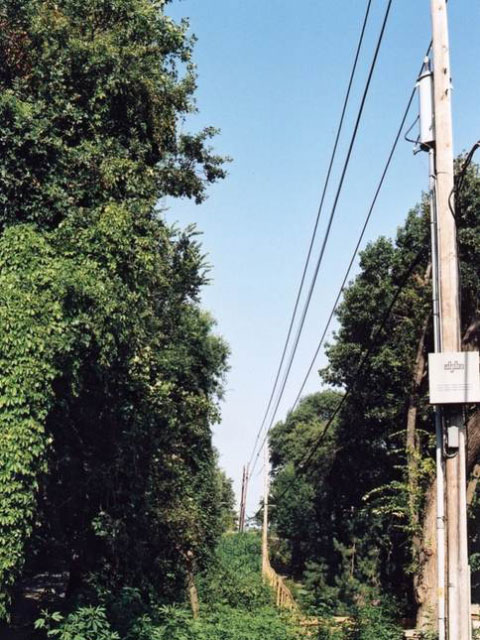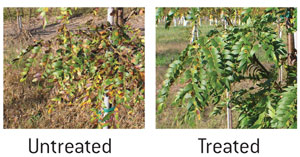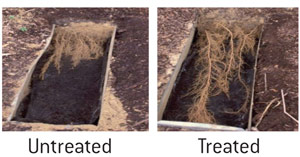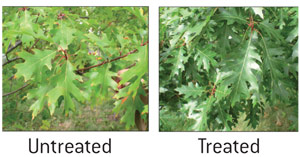How Does Growth Solutions Benefit Trees?
We approach every tree health problem with the same question: what does the research say? Because of our unwavering stand for scientific integrity, our company has been at the forefront of arboriculture technology for decades. We have been in the tree healthcare business for over 40 years and have a commitment to the well-being of some of our communities’ largest and oldest living things. The Growth Solutions Method, developed for the utility industry, is the first vegetation management solution in the nation that considers tree health along with the objectives of clear lines, safe and reliable electric distribution.
Improved Tree Health
The Growth Solutions Method utilizes a TGR (tree growth regulator) product with the active ingredient Paclobutrazol. This product is known to increase a tree’s fibrous root system, increase disease resistance, give the tree darker, greener leaves, and increase drought tolerance.

How Does Paclobutrazol Work?
The growth regulator, paclobutrazol, decreases elongated vegetative branch growth by inhibiting the formation of gibberellins (the group of plant hormones responsible for cell elongation). The tree still produces the same number of cells; however, these cells do not stretch out as far. Over three years, treated trees grow at a rate of 40-70% less than untreated trees.
Paclobutrazol is approved for use by the Environmental Protection Agency and is applied by our professional, licensed applications. Paclobutrazol effects are specific to processes only found in plants. In over 50 years of use, there are no reported adverse effects on people, pets, or wildlife when used as directed.
Research into paclobutrazol began in the 1970s, and its effects are well understood. There have been over 2,000 peer-reviewed studies published on the use of paclobutrazol in the past 50 years. It is utilized worldwide in agriculture, horticulture, and, of course, vegetation management.
Increased Drought Resistance
Plants respond to drought by utilizing hormones to close the ‘holes’ (called stomates) on their leaves that allow for water and gas exchange. When trees are treated with paclobutrazol, the reduction in the hormone associated with rapid growth (gibberellic acid) is related to an increase in the hormone used to close stomata (abscisic acid). Thus these slower-growing trees are also better adapted to respond to hot and dry environmental conditions resulting in more drought-resistant trees.

Improved Root Systems
Research has shown that plants treated with paclobutrazol show increased production of fibrous roots. This increased root structure helps the tree as it increases the soil area it can uptake water, minerals, and other resources. This is especially important for urban trees that are already challenged with poor soil conditions that often lack essential minerals.

Darker, Glossier Leaves
Treated plants often see an increase in the production of chlorophyll, the photosynthetic pigment that gives leaves their green color. There is also an increase in the thickness of the leaf’s cuticle layer which is the waxy covering that protects leaves from water loss and certain pests. The results are seen as shinier, darker green leaves that better resist drought and foliar pests.

Urban trees are living organisms. Whether a tree is in an open field, a small suburban yard, or right next to a utility line, we are committed to them living as long and complete a life as possible. Read more about how arborists use TGRs to improve the health of trees in many circumstances.
